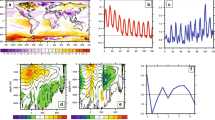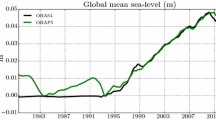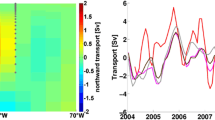Abstract
A 44-year (1958–2001) high-resolution atmospheric hindcast for the whole Mediterranean Basin was performed within the EU-funded Hindcast of Dynamic Processes of the Ocean and Coastal Areas of Europe (HIPOCAS) Project. The long-term hindcasted data set, which comprises several atmospheric parameters at different levels, was produced by means of dynamical downscaling from the NCEP/NCAR global reanalysis using the atmospheric limited area model REMO. The REMO hindcast has been exhaustively validated. On that score, various hindcasted surface parameters, such as 10-m wind field, 2-m temperature and mean sea level pressure, have been compared to satellite data (ERS-1/2 scatterometer) and in-situ measurements from offshore stations. In addition, two ocean models (waves and sea level) have been forced with REMO hindcasted fields (mean sea level pressure and 10-m wind field). The validation of these ocean runs, performed through comparisons of simulated waves and sea level with oceanographic measurements, allows to evaluate "indirectly" the quality of the REMO hindcasted data used as atmospheric forcing. Once the quality of the hindcasted data was verified, the efficiency of the regional enhancement performed through dynamical downscaling on the NCEP global reanalysis was assessed. The regional improvement was evaluated through comparisons of REMO and NCEP performance in reproducing observations. The important improvement obtained in the characterization of extreme wind events is particularly remarkable.











Similar content being viewed by others
References
Afifi A, Clark W (1990) Computer aided multivariated analysis, 2nd ed. Van Nostrand Reinhold, New York, pp 505
Bentamy A, Grima N, Quilfen A (1998) Validation of the gridded weekly and monthly wind fields calculated from ERS-1 scatterometer wind observations. Global Atmos and Ocean Syst 6:373–396
Bentamy A, Quilfen Y, Flament P (2002) Scatterometer wind fields: a new release over the decade 1991–2001. Can J Remote Sensing 28:431–444
Bentamy A, Katsaros KB, Alberto M, Drennan WM, Forde EB, Roquet H (2003) Satellite estimates of wind speed and latent heat flux over the global oceans. J Clim 16:637–656
Brody LR, Nestor MJR (1980) Regional forecasting aids for the Mediterranean Basin (Handbook for forecasters in the Mediterranean, Part 2). Naval Environmental Prediction Research Facility, Monterey, California, pp 178
Carretero JC, Álvarez Fanjul E, Gómez Lahoz M, Pérez B, Rodríguez I (2000) Ocean forecasting in narrow shelf seas: application to the Spanish coasts. Coastal Eng 41:269–293
Cox AT, Swail VR (2001) A global wave hindcast over the period 1958–1997: validation and climate assessment. J Geophys Res 106:2313–2329
Davies HS (1976) A lateral boundary formulation for multi-level prediction models. Q J R Meteorol Soc 102:405–418
DKRZ-Modelling group (1994) The ECHAM3 atmospheric general circulation model. Technical Report 6, Deutsches KlimaRechenZentrum, Hamburg, pp 184
Ebisuzaki W, Kanamitsu M, Potter J, Fiorino M (1998) An overview of Reanalysis-2. Proceedings of climate diagnostic workshop. Miami, Florida
Fanjul EA, Rodríguez I, Pérez B (1997) A description of the tides in the eastern north Atlantic. Progr Oceanogr 40:217–244
Feser F, Weisse R, Von Storch H (2001) Multi-decadal atmospheric modelling for Europe yields multi-purpose data. Eos Transactions 82(28):305–310
Frank HP (2001) Extreme winds over Denmark from the NCEP/NCAR Reanalysis. Technical Report Riso-R-1238 (EN). Riso National laboratory, Roskilde, pp 28
Gibson JK, Kallberg P, Uppala S, Hernandez A, Ñomura A, Serrano E (1997) ERA description. ECMWF Re-analysis Project Report Series 1, Reading, pp 72
Giorgi F (1990) On the simulation of regional climate using a limited area model nested in a general circulation model. J Clim Res 3:941–963
Gómez Lahoz M, Carretero JC (1997) A two-way nesting procedure for the WAM model: application to the Spanish coast. Transaction of the ASME 19:20–24
Graber HC, Ebutchi N, Vakkayl R (1996) Evaluation of ERS-1 scatterometer winds with wind and waves ocean buoy observations. Technical report RSMAS 96-003. University of Miami, Miami, Florida
Guedes C, Carretero JC, Weisse R, Alvarez E (2002) A 40 years hindcast of wind, sea-level and waves in European waters. Proceedings of OMAE 2002: 21st international conference on offshore mechanics and arctic engineering. Oslo, Norway
Günther H, Rosenthal W, Stawarz M, Carretero JC, Gomez M, Lozano I, Serrano O, Reistad M (1998) The wave climate of the northeast atlantic over the period 1955–1994: the WASA wave hindcast. The Global Atmos and Ocean Syst 6:121–163
Jacob D, Podzun R (1997) Sensitivity studies with the regional climate model REMO. Meteor Atmos Phys 63:119–129
Jones PD (1995) The instrumental data record, its accuracy and use in the attempts to identify the "CO2signal". In: Von Storch, Navarra (eds) Analysis of climate variability, applications of statistical technics. Springer, pp 53–76
Juang HH, Hong HS, Kanamitsu M (1997) The NCEP regional spectral model: an update. Bull Am Meteorol Soc 78:2125–2143
Kalnay E, Kanamitzu M, Kistler R, Collins D, Deaven D, Gandin L, Iredell M, Saha S, White G, Woolen J, Zhu Y, Chelliah M, Ebisuzaki W, Higgins W, Janowiak J, Mo KC, Kopelewski C, Wang J, Leetmaa A, Reynolds R, Jeene R, Joseph D (1996) The NCEP/NCAR 40-year reanalysis project. Bull Am Meteorol Soc 77:437–471
Karl TR, Quayle RG, Groisman PY (1993) Detecting climate variations and change, new challenges for observing and data management systems. J Clim 6:1481–1494
Kidson JW, Thompson CS (1998) Comparisons of statistical and model-based downscaling techniques for estimating local climate variations. J Clim 11:735–753
Komen GJ, Cavaleri L, Donelan M, Hasselmann K, Hasselmann S, Janssen PAEM (1994) Dynamics and modelling of ocean waves. Cambridge University Press, Cambridge, pp 560
Louis JF (1979) A parametric model of vertical eddy fluxes in the atmosphere. Boundary layer meteorol 17:187–202
Majewski D (1991) The Europa-Modell of the Deutscher Wetterdienst. ECMWF seminar on numerical methods in atmospheric models 2:147–191
Mesinger F et al. (2003) NCEP regional reanalysis symposium on observing and understanding the variability of water in weather and climate. AMS Annual meeting. Long Beach, California
Morcrette J, Smith L, Fouquart Y (1986) Pressure and temperature dependence of the absorption in long wave radiation parameterizations. Beitr Phys Atmosph 59:455–469
Nordeng TE (1994) Extended versions of the convective parameterization scheme at ECMWF and their impact on the mean and transient activity of the model in the tropics. Technical Report 206, ECMWF Res. Department, Reading, pp 25
Palitikof JP, Brabson BB, Lister DH, Adcock ST (1999) A review of methods to calculate extreme wind speeds. Meteorological applications 6:119–132
Parker DE, Folland CK, Ward MN, Maskell K, Bevan A, Jackson M (1993) Ocean-atmosphere climatic fluctuations on interannual to century time scales. Publ. of the Hadley Centre for Climatic Prediction and Research UKMO, Brackneel, Berks
Podzun R, Cress A, Majewski D, Renner V (1995) Simulation of European climate with a limited area model. Part II: AGCM boundary conditions. Beitr Phys Atmos 68:205–225
Quilfen Y, Bentamy A, Katsaros K, Lorand G (1999) Estimation of ocean-atmosphere turbulent fluxes from satellite measurements. In OCEANOBS99 – Proceedings of international conference on the ocean observing system for climate, St Raphael, pp 18–22
Ratsimandresy AW, Sotillo MG (2003) Reanalisis de 44 años (1958–2001) del clima oceánico y atmosférico en el Mar Mediterráneo: Informe técnico de la contribución de Puertos del Estado al proyecto europeo HIPOCAS. Technical Report. Ente Público Puertos del Estado, Madrid, pp 397
Reynolds RW, Smith TM (1994) Improved global sea surface temperature analysis using optimum interpolation. J Clim 7:929–948
Rinke A, Dethloff K (2000) The influence of initial and boundary conditions on the climate of the Arctic in a regional climate model. Clim Res 14:101–113
Roeckner E, Arpe K, Bengtstsson L, Christoph M, Claussen M, Dumenil L, Esch M, Giorgetta M, Schlese U, Schulzweide U (1996) The atmospheric general circulation model ECHAM4: model description and simulation of present day climate. Technical Report 218. Max Planck Institute für Meteorologie, Hamburg, pp 102
Rood RB, Hou AY, Pawson S, Schubert SD (2001) Reanalysis efforts in the United States: NASA and National Reanalysis Program. ECMWF Workshop on reanalysis. Reading
Simmons AJ, Burridge DM (1981) An energy and angular momentum conserving vertical finite-difference scheme and hybrid vertical coordinates. Mon Weather Rev 109:158–166
Sotillo GS (2003) High-resolution multi-decadal atmospheric reanalysis in the Mediterranean Basin. PhD dissertation. Universidad Complutense de Madrid, Madrid, pp 209
Sundquist H (1978) A parameterization scheme for non-convective condensation including prediction of cloud water content. Q J R Meteorol Soc 117:1641–1657
Tiedtke M (1989) A comprehensive mass flux scheme for cumulus parameterization in large scale models. Mon Weather Rev 117:1779–1800
Trenberth KE, Paolino DA (1980) The northern hemisphere sea level pressure data set: trends, errors and discontinuities. Mon Weather Rev 108:856–872
Uppala S (2001) ECMWF Reanalysis 1957–2001, ERA-40. ECMWF Workshop on reanalysis. Reading, UK
Von Storch H (1999) The global and regional climate system. In: Von Storch H, Flöser G (eds) Springer-Verlag, pp 3–36
Von Storch H, Zwiers FW (1999) Statistical analysis in climate research. Cambridge University Press, Cambridge, pp 484
Von Storch H, Langenberg H, Feser F (2000) A spectral nudging technique for dynamical downscaling purposes. Mon Weather Rev 128:3664–3673
WAMDI Group (1988) The WAM model – a third generation ocean wave prediction model. J Phys Oceanogr 18:1775–1810
Acknowledgements
The present work was realized within the EU-funded HIPOCAS Project (N° EVK2-1999-00248). Ente Público Puertos del Estado (EPPE) has been responsible for the implementation and execution of atmospheric and oceanographic (waves and sea level) hindcast systems for the whole Mediterranean Basin. In addition, EPPE now maintains a database that includes the atmospheric and oceanographic parameters generated by these hindcasts. The authors wish to thank to all the institutions and people who provided us with data: NCEP Reanalysis data were provided by the NOAA-CIRES Climate Diagnostics Center, Boulder, Colorado, USA from their Website at http://www.cdc.noaa.gov, INM (Spain), IFREMER (France), MeteoFrance (France), NCMR (Greece), Dr. Luigi Cavalieri (ISDGM, Italy). Thanks should also be addressed to an anonymous journal reviewer, as well as to Dr. H. Von Storch, Dr. R. Weisse, and F. Fesser (GKSS) for their constructive comments. Dr. D. Jacobs and R. Podzun (MPI) for their valuable help with REMO model and O. Serrano (EPPE) for his useful help with data analysis.
Author information
Authors and Affiliations
Corresponding author
Rights and permissions
About this article
Cite this article
Sotillo, M.G., Ratsimandresy, A.W., Carretero, J.C. et al. A high-resolution 44-year atmospheric hindcast for the Mediterranean Basin: contribution to the regional improvement of global reanalysis. Clim Dyn 25, 219–236 (2005). https://doi.org/10.1007/s00382-005-0030-7
Received:
Accepted:
Published:
Issue Date:
DOI: https://doi.org/10.1007/s00382-005-0030-7




